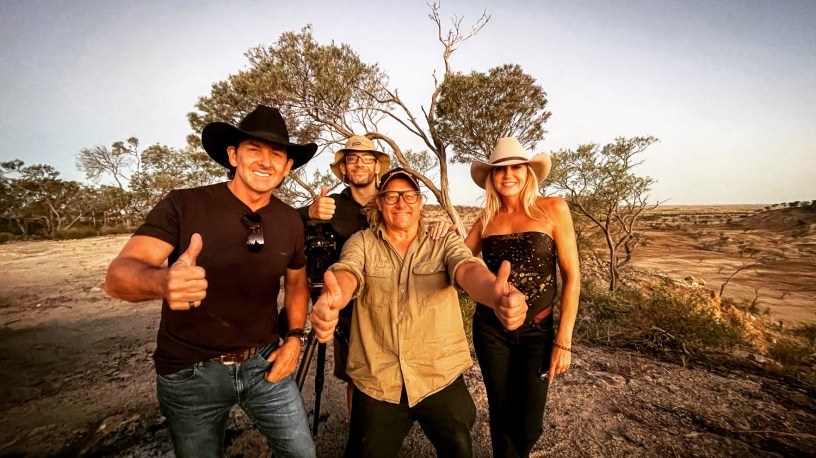As Kriv Stenders’ Lee Kernaghan: Boy From the Bush – part road documentary, part concert film – enters cinemas today on more than 130 screens, the creative team are hoping it will resonate not only in regional and rural Australia, but with those who have missed live music through the pandemic.
Boy From the Bush reunites Stenders with Slim & I producer Chris Brown and Diana Le Dean, both of Pictures in Paradise. It is in many ways intended as a companion piece to that documentary, which examined the relationship between the late country music legend Slim Dusty and his wife Joy McKean.
Released in September 2020, Slim & I grossed $432,524, resonating strongly in regional locations despite a very disrupted theatrical landscape – it was the highest grossing Australian feature doc of that year.
After being so deeply immersed in the country music scene for the film, Brown was sure there had to be another project there, so rich was the world.
The producer then visited Tamworth for McKean’s 95th birthday concert, where the surprise last act was Kernaghan and his band. It was immediately clear the iconic singer, songwriter and guitarist was a natural new documentary subject; one who follows in Dusty’s legacy.
“They blew the hats of the audience. There wasn’t an Akubra standing by the time he finished,” Brown says.
With Kernaghan as a subject, Brown, Le Dean and Stenders all saw a chance to create a film that was not just a documentary biopic, but a “love letter to rural Australia”, further tapping into a potentially underserved cinema audience.
The singer, who has won 37 Golden Guitars, sold 2.5 million albums, had 38 #1s, and is an former Australian of the Year, would also bring to the film his strong fanbase – one that, given his career spans 30 years, touches across generations.
Having also recently shot the Justine Clarke-hosted doc series Going Country for the ABC, Stenders notes many may be surprised to learn that country music is the fastest growing music genre in Australia.
“The depth of that audience is quite strong, quite large. That’s an audience that I don’t think Australian filmmakers really speak to very much; we tend to be very urban, very city-centric,” Stenders tells IF.
“It was great to make a film that was not only for urbanites, but for everyone. Hopefully it’ll play to the diehards in the heartland, but hopefully it’ll also introduce his music to an audience that wouldn’t necessarily listen to him.”
In crafting the project, the director was excited by the chance to create a concert film, unaware of any made in Australia since the ’80s with The Slim Dusty Movie and Australian Made. But pushing the format, the film is interspersed with documentary vignettes, filled with sweeping shots across the outback and countryside, as Kernaghan takes audiences on the road and speaks to the rural life and community that colours his lyrics.
“The idea of Lee being able to kind of talk about his songs in a poetic way rather than a literal way felt right. When we pitched it to Lee and his team, they loved it because Lee, to his credit, said, ‘Look, I’m not that interesting. I don’t want the film to be about me. I want it to be about what inspires me’,” Stenders says.
“The concept really tied in well with where Lee was at, where his management was at, and where we were at in terms of coming out with with a film that wasn’t necessarily a straight biopic – because I think a straight biopic of Lee would be basically an hour episode of Australian Story. It wouldn’t, I think, warrant a theatrical feature. That’s when we decided to be a bit ambitious and come up with this ‘tone poem’… a love letter to rural Australia, as seen through the prism of Lee’s songs and stories.”
La Dean agrees, noting she has been in love with the outback since Pictures in Paradise made The Proposition in Winton. “We never put a spotlight on rural Australia, and this documentary movie was intended to do that.”
Brown notes that regional cinemas have been on board with the film since Maslow Entertainment/Universal Pictures Content Group first pitched it to them, with the 130 screens expected to grow over the weeks in release.
“Hook, line and sinker, they were in for this film. They could see the audience; that people would come. And also, combined with COVID, there has not been a lot of live music and this film rocks – it really does – on the big screen… the concert is very full on. It’s a fantastic mix. It’s very colourful, vibrant.”
Stenders believes Universal has found a niche with feature docs with a subject that has a ‘brand’, noting his own films Brock: Over The Top and Slim & I, as well as Mark Joffe’s 2019 film Jimmy Barnes: Working Class Boy. To that end, Kernagan has also been heavily involved in publicity for the film.
“There is still a market for good feature docs. There’s still life in this Australian theatrical industry if you think laterally about it,” Stenders says.
But as Brown adds: “You’ve got to know your audience. It’s very specific.”
Next up, the ever busy Stenders is among the directors working on Disney+ dramedy Last Days of the Space Age, starring Radha Mitchell, Jesse Spencer and Deborah Mailman, and is also shooting a documentary series.
Meanwhile Brown has returned to his first love, horror, with Pictures in Paradise producing Kiah Roache-Turner’s Sting with See Pictures.
Should we expect another country music documentary from the trio? Watch this space: Stenders says he’s got a few ideas.


